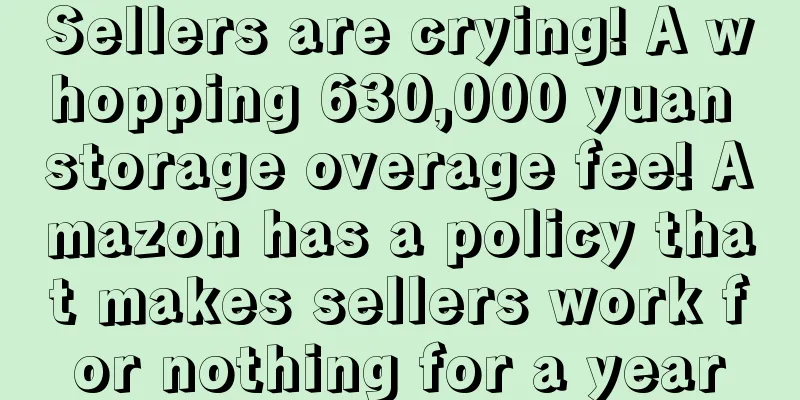It is learned that in the peak shopping season of 2021, the number of online shoppers will increase significantly, and online sales will also surge. Amazon sellers must be well prepared to face the peak shopping season. The following six measures will be of great help in increasing product sales. Estimate inventory needs for the fourth quarter and place orders 1. Check last year’s sales If the seller sells the same products during this year's peak shopping season as last year, then the sales volume of last year can be used to determine this year's inventory. Assuming that the sales volume of the product increased by 25% last year, then at least 25% more inventory should be ordered this year. Sellers can also view previous sales data through Amazon Seller Reports or use advanced inventory forecasting software, such as Inventory Manager, to help manage inventory levels and predict future sales. 2. Check your competitors’ sales If you are selling a new product and this is the first time you are preparing for the peak shopping season, you can first check the sales of your competitors last year to know the number of related keywords. Use Jungle Scout's extended function to view the competitor's historical sales record chart (as shown below) to understand how many units of a product are sold each month. In addition, sellers can use keyword scout tools to view the historical search volume of keywords in the niche market. For example, the seller searches for "Thanksgiving decorations" and the following chart will appear, which will show the search volume of this keyword in each month. We would like to remind all sellers to try to order product inventory before September 15 to ensure the normal circulation of goods and prevent supply interruptions, so as to better prepare for Black Friday, Cyber Monday and future holiday shopping. It is known that optimizing Amazon listings can improve product conversion rates and increase product exposure opportunities. To increase sales during the peak shopping season, setting keywords related to the peak season is the most important step. Keywords are the words that consumers think of first when shopping. All keywords that belong to the product can be displayed as product listings. Here are some specific measures Amazon sellers can take to optimize their listings:- Update your product images. Add some holiday-themed images to your product listings, such as photos of your products with festive backgrounds, special features, etc. Perform new keyword research using Keyword Scout to make sure you’re not missing any important search terms.
- If you have joined the Amazon Brand Registry, you can use the Brand Analysis tool to see which keywords your products or your competitors’ products ranked for during a specific time period during last year’s shopping season. Set some high-performing keywords on this year’s listings.
- Add holiday-related keywords to your product listings and backend search terms , such as "gift," "last minute gift," "gift for _____," "Christmas," "Black Friday," etc.
- Make sure your product listings show as much information as possible to avoid confusion that could put potential buyers off purchasing. For example, if you’re selling clothing, you can include size details and measurements in your listings.
Here is a reminder for all sellers that as the shopping season approaches, they should optimize their listings as soon as possible to avoid low product conversion rates. Of course, if sellers think their product listings do not need to be optimized, they can simply add holiday-related keywords throughout the listing to ensure that the product’s search volume increases, thereby increasing sales. Adjust your PPC campaigns and overall budget1. Figure out your target ACoS and RoAS During the peak shopping season every year, sellers will invest a lot of money in product advertising to ensure that product exposure is increased. Therefore, sellers need to understand the break-even RoAS and ACoS to closely monitor the performance of product advertising during the shopping season. Because more and more sellers will advertise their products during this period, sellers need to increase keyword bids appropriately based on their products to ensure that their products receive more impressions. Sellers can change their bidding strategy in Campaign Manager without having to manually change the bid for each keyword. By selecting "Dynamic Bidding - Up and Down", sellers can let Amazon automatically adjust keyword bids by up to 100%. Of course, if Amazon thinks your ad will not convert, it will lower the bid. 3. Test different advertising strategies If you sign up for Brand Registry, you can run many different ads on Amazon. - Sponsored Brands ads. Allow sellers to create a customized shopping experience on Amazon and avoid a large number of ads from competitors. After clicking on the ad, customers will be taken to the seller's Amazon storefront or a custom landing page to learn more about the product and brand.
- Sponsored Display Ads. Allows sellers to place ads in competitor product listings to increase their competitiveness. Most importantly, sellers can target customers who have visited product listings in the past but did not make a purchase, giving sellers a huge advantage over their competition.
- Sponsored Brand Video Ads: Allows brands to post video ads within Amazon’s search results to capture customers’ attention.
4. Target holiday keywords Target new keywords in your campaigns. Any words related to gifts or the holiday. For example, if you sell woven baskets, you can tie it into a Thanksgiving theme with keywords like "Thanksgiving decorations," "Thanksgiving holiday baskets," etc. Here is a reminder for all sellers to start adjusting their advertising campaigns on Amazon now to ensure that their products can sell well at the beginning of the peak season (late October/early November). It is reported that sellers can create deals and coupons in Seller Center regardless of whether they are brand registered. Providing discounts to consumers during major promotional events such as Prime Day or Black Friday can greatly boost product sales. To create a deal in Seller Central, go to the Advertising tab, click Deals, then click Create New Deal.Amazon will list the products that are eligible to participate in creating a new deal, and will also list the deal price, per-unit discount, and transaction fees. If a seller wants to create a 7-day deal, they will have to pay $300, and if a seller wants to participate in a daily lightning deal, they will have to pay $150. In addition, Amazon is likely to increase sellers' transaction fees during the peak shopping season. To create a coupon, go to the Advertising tab, click "Coupons," then click "Create a New Coupon." The coupons created by the seller for the product will be visible on the search results page (as shown above), so that consumers can clearly see the discounts and offers they can get. Here is a reminder for all sellers to create deals a few weeks before major shopping events or holidays to increase their competitiveness in the market. Predict potential shipment delaysDuring the peak shopping season or at the end of the year, Amazon's distribution centers will be full of goods and many goods cannot be delivered in time. If sellers delay the delivery of inventory to distribution centers, the speed at which goods reach consumers will also be greatly slowed down. Amazon has not yet recommended an inventory shipping arrival date for 2021. Sellers can refer to the dates Amazon recommended during the 2020 shopping season:- Inventory for Black Friday and Cyber Monday merchandise should arrive at Amazon fulfillment centers by November 6, 2020.
- Inventory for Christmas shopping should arrive at Amazon fulfillment centers by December 1, 2020.
- 2021 inventory should be delivered to Amazon fulfillment centers after December 17, 2020. Until then, only ship items to Amazon fulfillment centers that will sell in 2020.
- Please make sure to allow enough time for supplier delivery times or carrier delivery times. During busy shopping seasons, it may take longer for inventory to arrive at Amazon fulfillment centers.
Combined with the above, it can be seen that Amazon sellers must deliver inventory to the distribution center three weeks before the peak season to ensure the normal circulation of goods. In addition, sellers can also use Amazon's third-party distribution center to distribute their products, or ship directly from the seller's own warehouse.
Preparing for Holiday Returns Amazon is reportedly offering an extended holiday return policy for buyers in 2021. This means any orders placed between October 1 and December 31 can be returned until January 31, 2022. It is learned that during the peak shopping season, many sellers will face product return issues. It is reported that December is the best month for product sales, while January is the month with the highest return rate. In the Amazon seller forum, many sellers are uneasy about Amazon's extended return policy, believing that returns are troublesome, but they are helpless. Here we remind all major sellers that when preparing for the peak shopping season, they must ensure that the products are free of defects and quality issues, and that they can be smoothly delivered to consumers to reduce the occurrence of returns. Editor ✎ Nicole/ Disclaimer: This article is copyrighted and may not be reproduced without permission.
|










